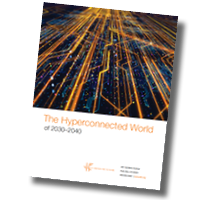The Hyperconnected World

The Hyperconnected World of 2030–2040
Much has been written about the advent of 5G in recent years. Press coverage has tended to focus on
deployment of the technologies that will enable the new high-speed network, or on which companies are
racing to win contracts in key areas of coverage. While these aspects are important, less thought has been
devoted to what the world looks like after 5G is successfully deployed around the world. What exactly
does the hyperconnected world of 2030–2040 look like? The hyperconnected world is a future in which
5G networks have been widely and globally deployed, and in which the normal, day-to-day functioning of
society depends on billions of connected devices having highly reliable, low-latency connectivity.
Simply put, this world means more data, more devices, and more interactions between the two. A hyperconnected world will support up to 1 million devices per square kilometer of coverage area, orders of magnitude more than the 60,000 devices currently possible with 4G LTE networks. Sensor devices will become omnipresent—20.4 billion devices embedded with connected sensors will be operative this year alone. In this future, the very definition of scale itself will change—instead of billions of devices, the world will support hundreds of billions, or possibly trillions. The total amount of data produced in human history, already doubling every two years, is likely to double every six months. While the figures are impressive, less thought has been given to what this world will look like, and what the positive and negative effects of hyperconnection are likely to be—until now. The goal of this report is to forecast the hyperconnected world.
Download the full report to read about areas of concern, takeaways from the expert workshop, and Hyperconnectivity in 4 Alternative Futures.
ACKNOWLEDGEMENTS
Experts:
IFTF convened a team of technology experts and researchers to look at the future of
the hyperconnected world in a day-long workshop in 2019.
Francois Bar
Avi Bar-Zeev
Marjory Blumenthal
Kevin Kelly
Monica Lam
Jim Spohrer
Mallik Tatipamula
David Tennenhouse
Anthony Townsend
Author: Nick Monaco
Co-Authors: Scott Minneman, Katie Joseff
Research Contributions: Mike Liebhold, Ben Hamamoto
Executive Producer: Jean Hagan
Senior Editor: Mark Frauenfelder
Production: Robin Bogott, Helen Bruno, Karin Lubeck, Robin Weiss
ABOUT THIS PROJECT
This report, The Hyperconnected World of 2030–2040 was made possible by the support of the Office of Director of National Intelligence. The findings are those of the Institute for the Future (IFTF) and do not necessarily represent US Government views.
For more information, contact:
John Clamme | [email protected]




